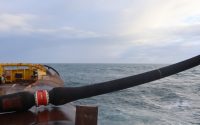How do container ships refuel?
Container ships are pivotal to much of the international trade that occurs across the globe. They typically carry manufactured goods and products from one destination to another on scheduled services.
The amount of fuel carried on board will depend on the ship’s engine capacity, size, and travelling speed. A ship that typically holds up to 5,000 TEU containers (twenty-foot equivalent containers) is often able to carry between 2.5 million and 3.5 million gallons of fuel. The speed travelled will then determine how quickly this amount of fuel is used.
These ships can travel at top speeds of 20 to 25 knots per hour, equating to a maximum of 28 miles per hour. In doing so, a typical container ship will consume around 63,000 gallons of fuel each day when travelling at that speed. Most major carriers will reduce their speed to around 19 mph to conserve fuel. By dropping the speed by around 10%, fuel usage decreases by almost a third.
On each scheduled service, there will be a designated refuelling checkpoint, to ensure that the ship consistently has enough fuel to account for all circumstances and the planned journey. The process of refuelling is called bunkering
What is bunkering?
The process by which ships are refuelled is known as ‘bunkering.’ This process covers the logistics surrounding loading and distributing fuel onto shipboard tanks.
The term ‘bunkering’ earned it’s name during the days of steamships, where the main source of fuel, coal, was loaded into bunkers aboard the ship. Nowadays, ‘bunker’ simply refers to the petroloum products that are used to power the propulsion system of a ship.
Problems that frequently occur during bunkering:
- Fuel spillage
The critical concern surrounding the spillage of bunker is the environmental impact of spills. Persistant oils like many heavier grades of marine diesel oil will have a harmful impact on the marine environment as it takes a considerable amount of time to dissapate. As a result, these types of spills often require a clean up operation, costing up to hundreds of thousands of pounds depending on the quantity of the spill.
- Damage to hose strings
There are a range of circumstances that can lead to increased strain on the hose strings that are used to supply fuel to a cargo ship. For example, tanker breakout or a failure of the mooring hawser that keeps the ship moored or towed to the bunkering vessel can cause over-stress to the fueling hose as the ship gradually drifts away. Replacement of damaged components becomes costly and inefficient throughout the bunkering process.
- Workforce injuries
To avoid accident and injury, it is vital that bunkering procedures are followed precisely. This is due to the numerous risks associated with offshore fluid transfers. One mistake or malfunction can lead to exposure to harmful chemicals, physical injuries and fire-related incidents. It is clear that safety mechanisms must be employed when bunkering to mitigate any risk to the health and safety of the crew.
How do Marine Breakaway Couplings help?
The problems mentioned above can individually impact the efficiency and wellbeing of a cargo ships crew. Significant delays can occur as a result, meaning a
They are two-part devices fitted onto independent hose pipes to be joined during the loading of LNG or oil onto a cargo ship. The mechanism is passive, with valves that are open during the transfer of fluid. When the hose exceeds the axial load, or there is a surge in pressure the MBCs seperate with a fail-safe that halts the flow of liquid.
One of the significant benefits of marine breakaway couplings is the containment of liquid in a range of applications. Variations of MBCs have been designed for different roles during bulk oil transfer. Addressing the aforementioned dilemma surrouding ocean spillages, the marine breakaway couplings offer an effective and proven solution that makes a decisive impact on the environment and marine life.
Additionally, the mechanism by which MBCs function strive to shield the fuelling components and assets from damage as a result of tensile load and pressure surges. Even in the event of accident or error, the sections of the hose are able to seperate due to the high tensile load predictability of the break bolts, providing a reliable fail-safe in urgent situations.
Final Thoughts
Container ships refuel during a process termed ‘bunkering.’ This refers to the procedure of loading fuel onto a ship from an offshore tanker. The process can be complex and surrounding by risk, with significant attention paid when spillages into the ocean occur as a result of accident or error.

